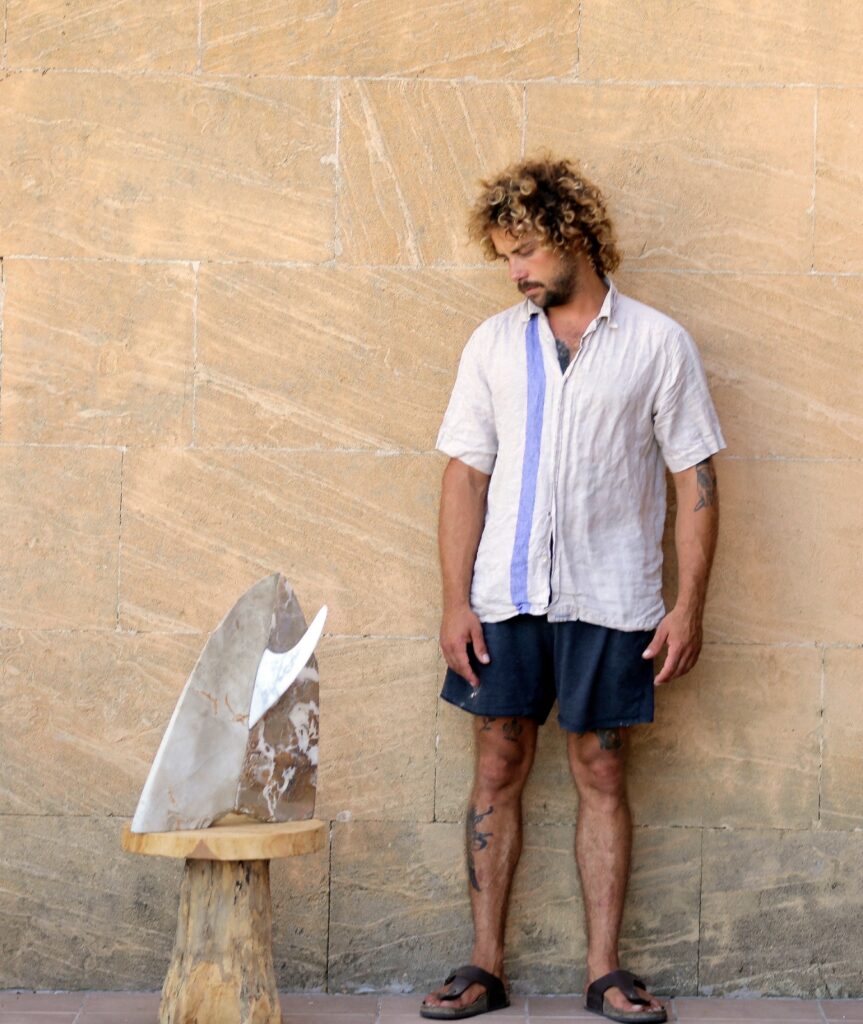Biel Miralles


Biel Miralles Flaquer’s first contact with art was through his great-aunt, Francisca Pou (painter), who taught him the plastic arts and painting techniques at the age of 6. From 2010 to 2014 Biel studied the degree in fine arts at the University of Vigo, in the city of Pontevedra, Galicia, Spain. Later, he completed a postgraduate degree in Fashion Design at the Esdenga school. Throughout 2016 he lives in the city of Porto, where he specializes in classic plaster moulds, at the University of Fine Arts of Porto. In 2017, Biel returned to Pontevedra to spend a year at the Escola de Canteiros where he learned the traditional Galician craft of stone carving. That same summer, he works as a surf instructor at the Raz surf camp, where he meets Boris Bugarski, who becomes one of his main teachers as he teaches him how to make surfboards. After Biel returned to Mallorca, where for 2 years he created surfboards under the name “BocBoards”, while continuing to experiment with sculpture with different materials such as wood, stone, polyester resin and fiberglass. These last two years Biel has consolidated his work to focus on sculpting with stone.
What is your discipline and when did you first encounter it?
Currently my discipline is sculpture. Before I had a painter’s eye, since I looked at the colour of things and tried to break down all the tones to create that colour. The day I discovered the stone my gaze focused more on volumes, textures and shapes. Now I’m obsessed with looking at the stones I find wherever I go, both on the side of the road and at the bottom of the sea. I even like to go to sleep creating a stone sphere in my head. I guess I’ve always been fascinated by classic marble sculptures, dreaming of one day making one.
What was your journey to becoming an artist?
My first experience with art was my great-aunt “paca”, she was a great watercolorist and painter, at the age of 6 I started going to class with her and she taught me the plastic arts and pictorial techniques and I remember perfectly the day that I went to the countryside and faced a blank canvas and oil painting for the first time. I never finished that painting and I think that was something that affected me for many years when creating, that I almost never finished my works and sometimes I feel the need to leave things unfinished – every time I look at them I try to imagine how sculpture would continue, I have works that I started more than 10 years ago…
Another important fact in my life related to art was studying the artistic bachelor – clearly my favourite subject was sculpture with a good teacher named Alfons Sard who above all taught us the art of clay and its baking. When I studied fine art I had two teachers who marked me a lot, one was the art and nature teacher Fernando Casás who was one of the fathers of art and nature in Brazil and his subject was based a lot on debate. The other was Manolo Molds who was more than a good teacher, he was a great artist being one of the best known painters of his time in Galicia. He was one of the only ones who invited me to his studio and I saw the world of an artist. Another great reference was my uncle Ivan Montaña, since he was a consolidated artist and when I visited his workshop I imagined having mine and today he is my greatest artist colleague with whom I can have interesting conversations with.
Another person who influenced me was Boris Bugarsky who taught me the art of making surfboards and I spent a year working with him in his workshop and learning his way of working. With some techniques being used in the way I work now. That experience helped me to professionalize creating my own surfboard workshop and later sculpture. This is how resin and all its possibilities came into my life.
My way of working and thinking comes from my parents, my sensitivity towards things comes from my mother, who is a motivating woman who played the piano for me before going to sleep and instilled in me a very good philosophy of life. From my father’s work, the use of tools and the passion for materials.I could say that my mother was the mother of creativity and my father the father of ingenuity. So my way of working is very much based on creativity and ingenuity – I like to create with my mind but I am fascinated by the way to solve a technical problem. A clear example is the “Tangram” Collection, which consists of 4 marble tables in which I play with their shape and weight, which by fitting together find a balance both visually and structurally, this collection is inspired by the Asian game tangram that consists in creating different shapes from 7 geometric shapes. This puzzle consists of first creating the shape you have to make with your head and then executing it, thus working on creativity and ingenuity.
My material par excellence is stone, the first time I worked with it I felt powerful, it is a very hard material, both physical and psychological, if you hit it too hard it can break and if you hit it too lightly you will not advance, not the whole world is made to crush stone, sometimes the stone defeats you. I like to think that the works I am creating are going to last a very long time. Moreover, the Collection that creates “Objects For The Sea” is based on creating objects simulating that they were created many centuries ago by some ancient civilisation submerged by the sea, thus reaching us a very old message but created today, every stone has a very ancient. I like to imagine how that piece of stone was created.
To finish I will talk about surfing that during most of my life has guided and influenced me so much in my art. Not only for using the element symbolism of surfing, but also for that obsession with the sea, and the fixation with organic and fluid forms. I can’t spend a lot of time working on the same project, a month at most, but I like to work fast, that’s why I use mechanical tools such as chainsaws and radials. I had a classic stage where I learned to work stone in a traditional way without mechanical tools and it was very important to go through this process to understand the stone well and by this I mean respecting the veins, to feel the hardness of each type of stone and especially the psychological part of the stone, the Galician saying expresses it very well “there is no hard stone, there is brando stone”.
I like to leave the mark of the tool as if it were the texture of a brush stroke and I notice things like organic shapes work very well when pigeonholed into a geometric shape.
Who are the key artists whose work inspires your own?
The truth is that I never had a main reference to follow, but I suppose that many influenced my art. I was always fascinated by classical sculptors like Miguel Ángel, Donatello, Bernini… I imagine them facing a giant block of marble (one day I will be able to face it too).
I like the Spanish artist Gargallo with his search for a way to represent a human body. There is also Francisco Farreras and his abstract paintings are so powerful and suggestive. One of my latest discoveries is the Catalan artist Pitxot, his work is pure sculpture represented on a canvas. I am attracted by his way of representing a human body joining stones. I feel very represented because one of my exercises is to look for forms in nature that imply something. But the artist that I usually have more in my head is Miquel Barcelo, mainly because he was born in Mallorca and I think that the people of the island have a character that defines us and his work could not be more organic and by this I mean those forms or rendered textures that could be created by nature, and that sensibility is only created by looking at it.
Tell us about your studio?
I could not have a better workshop, it is in the middle of a forest in front of the sea, in summer I take a break and go down to the sea and clean myself of dust. I have two construction containers, one is to create my surfboards where I have it equipped with its lights and trestles to place the boards. The other I use for the resins, since it is better insulated and has air conditioning. I have a stone section that is a small tent created with wooden beams and a boat sail (this is where I spend the most hours) and I have an area to work with the logs and the chainsaw. The truth is that my way of working is not very organized, so my workshop is usually chaotic, but I feel very comfortable.
Who's on your dream dinner party guest list, and what do you serve?
I would like Leroy Grannis, a surf photographer who captured the entire era of the 60s and 70s, to be there to tell us about the battles of that time, such as the giant waves surfed by Greg Noll. My grandfather Biel Flaquer, who was a very interesting character, a photographer who also spoke artistically, I only knew him through his photographs and a small book he wrote “Reflection On Death And Faith In God” and I know that if I could have dinner with him he could teach me many things. Of course I would have to be shrimp and paco de lucia and be all night partying. Chavela Vargas also has to be at this dinner, and if possible I would like to invite Gandalf the Grey, Frodo and his uncle. First I would like a prawn cocktail that I haven’t eaten for many years with prawn and bamboo momos and some grilled scallops, secondly a sea bass in salt accompanied by a tumbet (Majorcan dish of fried potato with tomato sauce and aubergine fried). And tiramisu for dessert. With the first red Vermouth or a Pedro Ximenez and for the second a very fresh Albariño. To finish a lot of whiskey – Lagavulin.
What's a film you watched and book you've read recently that had an impact on you?
I loved the journey of Spirited Away from Studio Ghibli and the book “The Doctor” and the “El Sanador de Caballos”
If you weren't an artist, what would you have been?
Something related to sports, like a firefighter or sea rescue, I wouldn’t mind dedicating myself to teaching young children either. Or to music.

